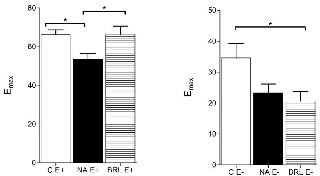Print version
Search Pub Med
| 009P London, UK Pharmacology 2017 |
Regulation of Na+-K+ pump by β3-adrenergic receptors in aortas from noradrenaline-treated rats
Introduction: Na+/K+-ATPase (NKA) plays an important role in the regulation of vascular tone and membrane potential. However, inactivation of NKA during sympathetic overactivation results in ionic dysregulation. Cardiac β3-adrenoceptors (ARs) are known to mediate NKA stimulation which is likely to represent a compensatory mechanism (1). However, their effect on vascular NKA isn’t known. Therefore, we aimed to investigate the effect of β3-AR stimulation on NKA activity under high noradrenaline concentrations.
Method: Sprague Dawley rats were divided into three groups: control, noradrenaline-treated, noradrenaline+BRL 37344 treated groups (n=5 for each group). Rats received noradrenaline (NA) (4 mg/kg/day) ± BRL (10 mg/kg/day) for 14 days via osmotic pumps. Systolic (SBP), diastolic (DBP) and mean arterial blood pressures (MAP) were investigated. Relaxation curves to KCl (0.1-10 mM) were analyzed in aortic rings with/without endothelium. NKA activity was expressed as KCl-induced relaxation in arteries incubated in K+-free solutions (2). All data are expressed as mean±S.E.M. Multiple comparisons were performed using one way ANOVA followed by Bonferroni test.
Results: Noradrenaline-treated rats have higher aortic weight/length ratio. They also have higher blood pressure values (Table 1). These hypertrophic and hypertensive effects were abolished after BRL treatment. Moreover, NKA activity was significantly decreased in noradrenaline-treated rats. BRL treatment abolished this decrease and stimulated NKA (Emax (%) C: 66.1±2.5; NA: 53.6±2.9; BRL: 66.3±4.3). However, this stimulating effect of BRL was lost when endothelium was removed (Emax (%) C: 34.5±4.7; NA: 23.3±2.8; BRL: 20.6±3.2) (Figure 1). On the other hand, in the presence of ouabain, KCl did not generate a relaxing effect which confirms that this effect was entirely mediated by NKA.
| C | NA | NA+BRL | |
| Aortic weight/10 mm length | 11.2±0.8 | 14.7±0.8* | 11.8±0.4 |
| SBP (mmHg) | 103.4±2.3 | 131.2±8.9* | 103.9±2.8 |
| DBP (mmHg) | 72.1±2.6 | 91.2±10.8 | 71.5±3.2 |
| MAP (mmHg) | 92.0±1.2 | 108.2±3.5**,## | 93.1±2.9 |
Table 1 Group comparison of aortic weight/10 mm length ratio and blood pressure values. (n=5)*0.05; **p<0.01 vs. control; ## p<0.01 vs. BRL-treated

Figure 1 The maximum responses to KCl. Four aortic rings were used from each rat (n=5 rats per group), two rings were used with intact endothelium and endothelium of other two were removed. *p<0.05
Conclusion: β3-ARs stimulation by BRL 37344 improved hypertrophic and hypertensive effects of noradrenaline treatment. NKA activity, on the other hand, was found to be decreased under high noradrenaline concentrations whereas β3-ARs activation stimulated pump activity in an endothelium-dependent manner.
References:
1. Bundgaard H et al. (2010). Circulation 122(25):2699-708.
2. Chen SJ et al. (2005). Shock 23(2). 179-185.

